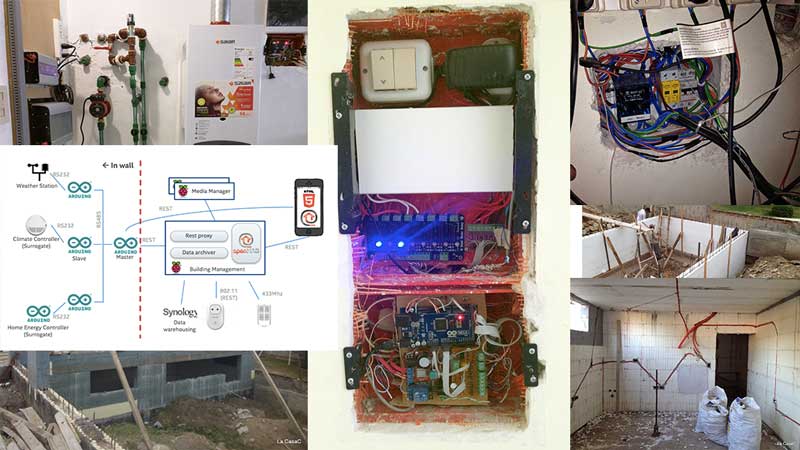“Jarvis, make me a sandwich” is not a reality yet. Though there exist a lot of home automation products out there today, commercial solutions just don’t make the cut for the self-respecting geek. So [Matias] took the DIY route with his La CasaC Home Automation project and achieved the functionality he was after.
[Matias’] project is one of the most elaborate and large-scale DIY home automation projects we have seen in recent years. With over 200 nodes, this project took a number of years of planning and execution. The core of the design is the ever popular Raspberry Pi running OpenHAB to ease the pain of customization and integration with various protocols. To further simplify the ginormous task, the design uses RS485 to communicate between master and slave devices.
Each wall node is managed by a nearby Arduino which in turn talks to a central Arduino Mega. OpenHab takes care of the higher functions such as UI, integration with existing hardware such as the solar heater, media center control, and RFID and keypad control. Sensor data aggregation and building management is done centrally with data funneled to a separate NAS system as long-term storage.
What makes this project awesome is that [Matias] did not integrate a Raspberry Pi into his house, no! He actually integrated his entire house around the system because this build includes the construction of the house as well. Take a look at this Google Photos Gallery to see the photographic progress of the build. That is amazing!
The code and snippets are available on GitHub for your viewing pleasure though that seems the easy part. If this inspired you, then also take a look at the Raspberry Pi Home Automation of a Gingerbread House if you’d like to try it out before fully committing.















It’s good to see OpenHAB finally getting some love. I’ve been working on something similar using a hub-and-spoke network topology with mains powered ESP32s routing data over WiFi from a bunch of nearby battery powered BLE sensors/actuators. Still, it’s a huge undertaking and very impressive that he put that many things under centralized control.
Is it possible to send a message from a slave to another without the master relaying it ?
How much time spent to send a switch info from a slave to a lighbulb in another slave ?
This was one of the critical concerns early on the design. Most of the “action” will happen instantly and be handled by a single slave. When “actions” are more complex they have to go through the master and the worse case scenario is 500ms (basically the master polls every slave every 250ms)
Hard part of automation isn’t the on/off part, but the presentation of all that in a human friendly manor.
Hehehe.
“Human friendly manor.”
Hehehe.
Agree, my design goal has been that the occupants should start to doubt if they did something or the house did it for them. It is very annoying when the house does something unexpected..it looks dumb
FWIW: “Mi casa es una tecno casa.”
I think the pun derives from “Mi casa es tu casa”, the error would be “Me” instead of “Mi”
… which in English “Me” sounds like “Mi” in Spanish …
It’s definitely a smart move to use some nice open components, like OpenHAB and RS485. A friend of mine went down the proprietary bticino route and is currently getting stuffed by manufacturers and installers, with expensive parts and lack of control and software options.
I hope this guy put in nice wide conduit for easily replacing and extending the networking lines, I would love to see a similar project done on an existing house using BT5 to avoid having to rip all the walls out.
I lived through proprietary stuff before (X10 + Bosch Alarm). This is why I took this turn. I’m not a fan of wireless, because where I live house are made of bricks and iron so getting good coverage is hard. If I would have to do it again I might use more 802.11 and the ESP8266. Still, failure isolation and resilience would suffer…. imagine if a router goes bonkers… it would be hard for the system to determine level of degradation and adapt (things I do today with RS485 and realtime constraints..)
For a new build wired is clearly the way to go, but my house was built in 1927 so I don’t have the luxury.
What made you go RS485, did you consider any other methods? Canbus always seemed to me to be well suited to this kind of thing.
BT5 is mesh-able, so I am hoping to be able to access to everywhere just by having enough components spread around, or some mini-repeaters if necessary. I would prefer to have something with canbus’s ability of error correction.
I researched several buses, I was looking for something open & off the shelve… I even wanted to use some existing protocol (I did not find one). I think I could not find articles about CAN on large are deployments (100meters). What I liked about RS485 is that it has many years under its belt. One proof was that at the beginning I had issues with the length of the bus (going all the way to the street.. i. 50meters). I solved all this and added robustness buy getting an off the shelve RS485 switch (and I didn’t even had to change my software)… You are right..mesh networks might be te future.